


Rebecca Ann Partleton (1836-1924)
aka Ann Caroline Partleton
OK, so why does she have two different names? Good question. And just one of many surrounding this Victorian orphan. We'll stick to calling her Rebecca because clearly that is how she preferred to be named.
We'll be stretching our detective skills to the limit to trace the story of her life. Rebecca was born into a world wholly without any privileges, and this is apparent in many of the documents which reveal how hard she had to work, the lengths she had to go to, and the white lies she had to tell just to keep her head above water. Through it all, she manages, just about, to keep her little family together and I've got to say that it's quite admirable. Click here and use the ‘Search’ button in the PDF document if you wish to remind yourself where Rebecca sits in the tree. You'll find her under both names.
To know Rebecca, you should first read the story of her mother, Ann Rebekah George (1802-1845)....
...Now that you are back with us, we may assume that you have seen the very difficult start to life which the unfortunate Rebecca experienced, which we'll briefly recap:
She was christened on 6 November 1836; here we see her birth name is Ann Caroline Partleton, the name which she dropped in favour of Rebecca Ann.

Rebecca's dad, Thomas, died when she was just two years old. Her baby sister died in 1839, and then her big sister Emma died when Rebecca was just 3. Soon after, Rebecca finds herself with her mother and brother in Newington Workhouse aka Walworth Workhouse which we see below.
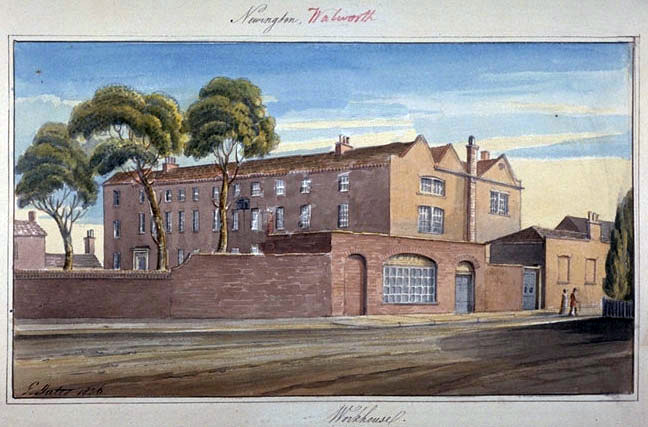
In 1845, when she was 9, her mother (Ann Rebekah George) passed away in the Workhouse, leaving Rebecca an orphan, with only her older brother Thomas (1831-1899) remaining as immediate family.
At this time, little Rebecca, whom God seems to have dealt a harsh deal, gets a small break, for she is taken out of the workhouse by her mum's brother, Richard George. Richard was a house painter, like Rebecca's father. Since Richard was good enough to implement this charitable act, there is at least hope that Rebecca was loved and cared for in her uncle's house. This charity, however, did not extend to Rebecca's brother Thomas who was 14 at the time of his mother's death - practically an adult by Victorian standards - and apparently too old for Richard to take in. Thomas had to stay in the workhouse, and his tale is to be found on his own page in 'In Their Shoes'.
So, if we are to step into Rebecca's shoes, let's take a look at where she is six years after her mother's death, in the 1851 census: with her Uncle Richard and Aunt Susan at 12 Baker's Row, near to Camberwell Green:

Rebecca took a bit of finding in the 1851 census, for if you look closely, you'll see she is listed (incorrectly) as Ann C Partington. The most likely cause of this is a transcription error by the census enumerator at the time, though it is possible that her uncle Richard didn't know her proper surname.
The next time we encounter Rebecca - ten years later - she is a grown-up, and we may note that she has dropped the name Ann Caroline, and for the rest of her life refers to herself as Rebecca Ann, except occasionally in formal documents where she gives her actual birth name. Why did she change her name? I'll speculate here that this is out of respect for her mother Ann Rebekah.
Anyway, here is Rebecca, making her own life as a domestic servant in 1861 in Walworth, aged 24:
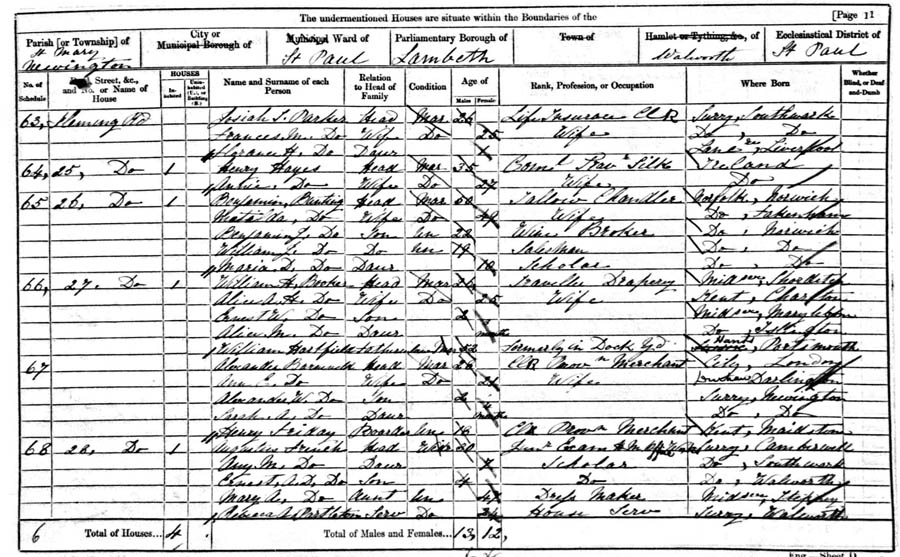
She is a servant at 28 Fleming Road, the home of Augustus French, an office worker. If you can decipher Augustus' job title, please tell me what it is, 'cause I can't figure it out.
In response to that appeal, the Partleton Tree received two replies:


Fleming Road is just behind Kennington Park, a few streets away from where Rebecca grew up with the Georges (Baker's Row on Wyndham Road).

So far so good. A very difficult and testing life for a young woman... however, after this, believe it or not, Rebecca's life gets much more complicated.
She may be pregnant in the above 1861 census, or maybe not. Because in the 1881 census as we shall see below, she reports a 20-year-old daughter; Annie. However, no record of this can be found in the state birth index.
In 1865, we are now quite certain: Rebecca has become pregnant and it is impossible to imagine that she would be permitted to continue anywhere as a domestic servant with a new-born baby. This may explain why we see on the following birth certificate that illegitimate baby Hannah is born in Shoreditch Workhouse. It's the only place Rebecca can turn to with her unsupported child.

Note above that Rebecca has declared her birth name of Ann.
The Shoreditch Workhouse building still exists; imagine how daunted Rebecca feels as she walks up to the main entrance with its intentionally imposing pillars on Kingsland Road:

Below we see the rear of the building; the tall windows at the left identify the dining room.

Residents of the workhouse were classified as 'paupers'. If you were poor, but not resident in the workhouse, you could go to there to collect a handout of relief money. You were then classified as a 'casual pauper' or simply a 'casual'. The entrance to the Parish Relief Offices fronted on to Hoxton Street at the west of the workhouse which we see below. I'm pretty sure Rebecca would also be familiar with this aspect of the workhouse:
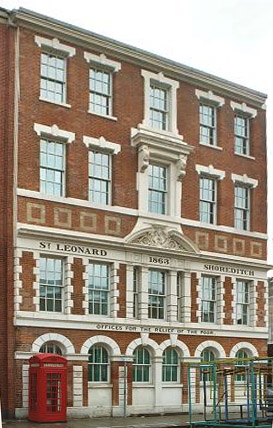
Below we see the location of Shoreditch Workhouse, outlined in red:

It's probably worth a small detour here to step into Rebecca's shoes because we have some really good stuff on Shoreditch Workhouse.
At some time after this, Rebecca is discharged from the Workhouse; in 1869 we find that she has become pregnant again. This time she is living at her own address; 20 Haggerston Road, Shoreditch, which we see nearby in the map above.
Here's the birth certificate of her child, Emma Partleton:
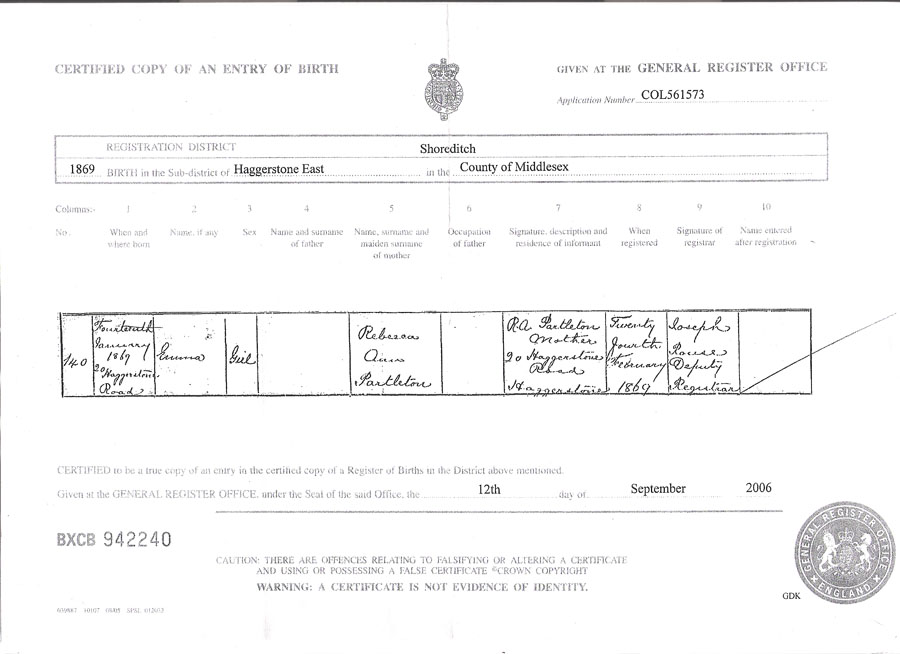
On the birth certificate Rebecca declares her preferred name of Rebecca Ann. As we can see, again, no father is named, meaning baby Emma is illegitimate. So how is Rebecca going to manage on her own with her new baby? The hard answer is that she has to return to the workhouse to survive. Below we see the Admission and Discharge Register for Shoreditch Workhouse for 1869: (thanks to Terry Partleton who retrieved this from the London Metropolitan Archive)

We see that Rebecca, using her birth name of Ann Partleton, signed herself in on 12 March 1869 with her baby Emma - just 8 weeks old - and her four-year-old daughter Hannah. We can see that little Hannah stayed just 11 days before being separated from her mum and shipped off "To Brentwood" on 23 March. Rebecca and the baby left 11 days after this on 03 April "at own request".
A couple of things to note on the above register... one quick way out of the workhouse was simply to die. On this short list, Ann Pilgrim, aged 21, entered on 25 January 1869 and left on 26 January... in a box. Likewise Francis Paine on 11 June; "Dead" written in a delicate script. The other thing to observe is that two little girls aged 4 - Hannah Partleton and Isabella Pereira - were taken from their mothers arms and sent "To Brentwood".
So what did being sent "To Brentwood" mean for little Hannah Partleton? A bit of detective work reveals the answer...

"Brentwood" is also known as the Shoreditch Industrial School. This is where the Shoreditch Workhouse children were sent when their parents died or simply could not afford to look after them. Below we see a picture of it:

Years later the Brentwood school was involved in a scandal in which "a girl inmate died for injuries sustained after being pushed downstairs by the nurse, Elizabeth Gillespie". Gillespie went to jail. After the report of this child’s death a "regime of terror that had reigned for many years, with the head mistress giving the girls black eyes and beating them with a ruler" was revealed. This was 20 years after Hannah was there, but there's no doubt that life in such places places in Victorian times was unremittingly grim.
The poor little 4-year-old waif Hannah Partleton was in this institution for at least two years, because that is where we find her at the tender age of 6, in the 1871 census. Her listing says 'Where born"... Unknown:
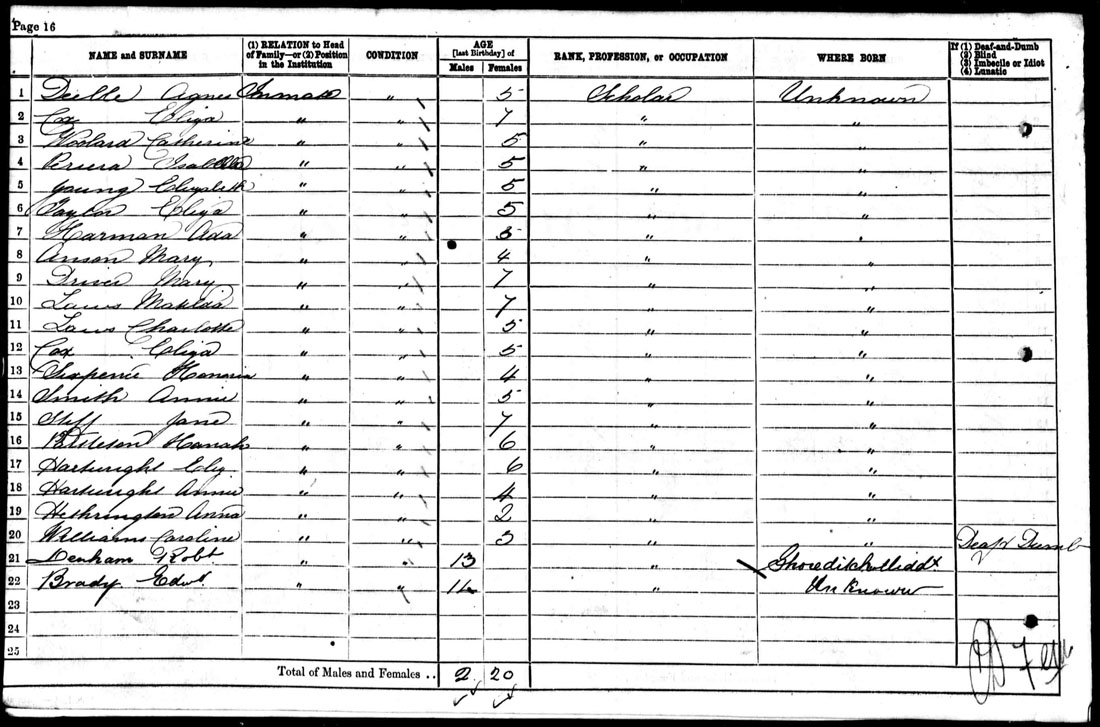
So, where is Rebecca on this day, the day of the census, Tuesday 3 April 1871? There's no doubt that she's struggling to keep her head above water. Surprisingly, she is back in Newington, where she grew up, and is on her own. She is again a domestic servant and reports her status as "Married". But her surname says otherwise - she is still a Partleton, as we see below:

So, back to the census, where is Rebecca's baby Emma, who is now 2 years old?... she's in Shoreditch...
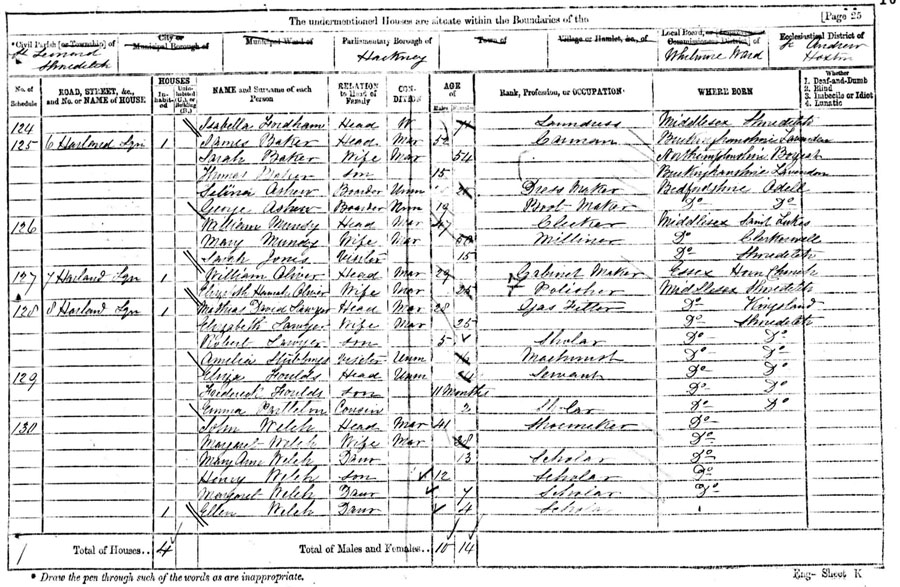
Emma is being looked after by Eliza Foulds, who has a little baby boy of her own. Emma is claimed to be Eliza's "Cousin", mmm,,, perhaps we shouldn't take this description too literally. Also, do we think that Rebecca has told her employer that she has a baby halfway across London and a toddler in an orphanage? I guess not.
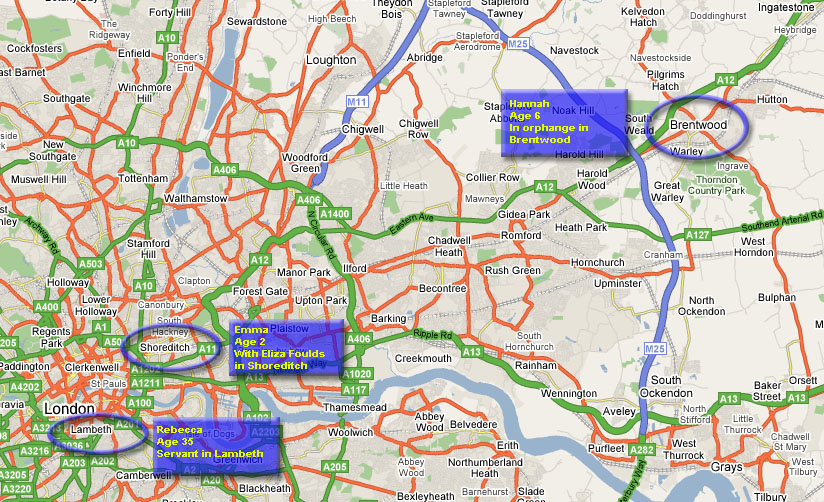
The above map illustrates Rebecca's predicament. She's earning minimum wage in Lambeth; paying someone else to look after her baby in Shoreditch; and somehow has to sustain a connection with little Hannah in Brentwood which is a long way away.
While we are here, we can look at the street where Rebecca is living in 1871. On the census it is blandly described as 'Newington Court', but it turns out this address is right next to the police station on Blackman Street, Southwark - practically the same address where her aunt, Eliza Catherine Partleton, had lived 20 years earlier in 1851. I make no apologies for using the same painting of Blackman Street since it's such a great one, and it is bang-on the right date for Rebecca:

The view is facing north towards the church of St George the Martyr, circled in blue. Rebecca's room is at the south end of the green circle, next to the police courts:
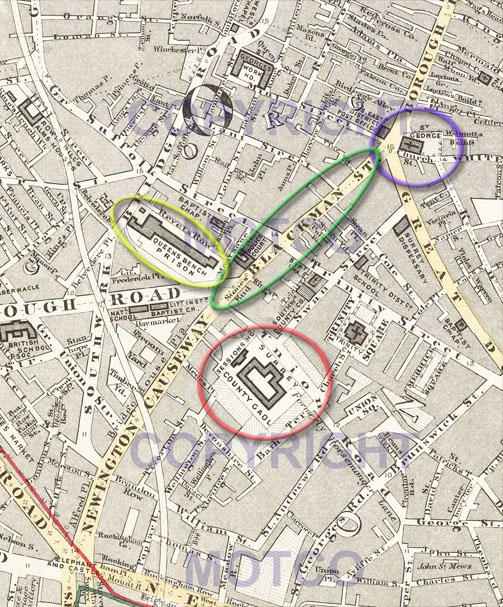
In the 1881 census, Rebecca is back in the East End, and all becomes much clearer:

Above we see the whole family is reunited in Hackney, East London. Rebecca is doing her best to hold things together. She now reports herself to be a widow, by trade a charwoman, and incorrectly reports her age as 35. Then her children; Annie born 1861, a Collar Box Maker; Hannah born 1865, a Boot Machinist; and Emma aged 12. At least they have three incomes however small these may be. This is our only sighting of "Annie" aged 20... who is she? It says she's Rebecca's daughter but this goes against all the other known facts.
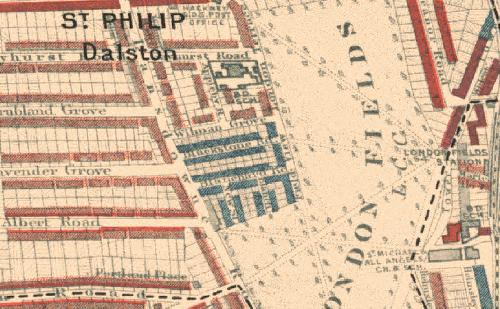

Their address of 9 New Street can just be discerned in the blue section of the above map, right next to a park called London Fields. In the modern satellite photo we can clearly see the Victorian path lines in the park are unchanged. Below we see London Fields in context in the general area of Hackney:


Here's Charles Booth's description of New Street in "The Poor Block on the West Side of London Fields" for his 1898 poverty map of London:


These Victorian blocks at London Fields have since been demolished and replaced with the buildings seen below.
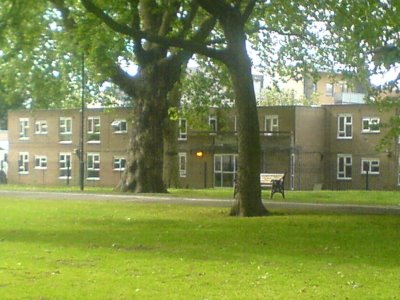
Back to the family: five years after the census, the girls are growing up, and when we search the records, we locate the Marriage Index for February 1886. There is a surprise because there appears to be a double wedding; both Annie and Hannah are named as married at the same time in Shoreditch:

This is a good moment to acknowledge Terry Partleton for all the certificates which appear on these pages. And here is what Terry found when he requested both marriage certificates:

Just one certificate was found. Only one Partleton was married. The wedding was at St Augustine's Church, Haggerston, Hackney, Sunday 28 February 1886. It took a while to figure out what was going on here. This is a modern copy of the actual register and sometimes you can't see the wood for the trees, but eventually the penny dropped (well spotted, Janice). It seems to be the wedding of Annie, as clearly stated. But look at the signatures... it is signed Hannah!
The birth date corresponds to Hannah who was born in 1865, and there seems little doubt that it is she who has just been married. But it is very difficult to reconcile this certificate with the 1881 census. Is Annie / Hannah one person, or two? Why does she declare her name to be Annie when we have seen on her birth certificate that it is definitely Hannah? If she has an older sister called Annie, as seems undeniable in the 1881 census, why would she use the same name?
The wedding took place at St Augustine's Church which we see circled in Yorkton Street below:

St Augustine's church stood derelict for 30 years from the 1960s until it was redeveloped into a restaurant and art gallery in 1998. Below we see some pictures of it; it's called Gallery 291:


Back to the marriage cert, which is stacked full of fascinating information. We know that Hannah is illegitimate - but here her father's name is revealed to be Edward, by trade a Porter, which is probably true. But they have declared his surname name to be Partleton - which it is not - rather than broadcast Hannah's illegitimacy on the permanent record.
Five years later, in the 1891 census, it can be seen that Hannah definitely prefers the name Annie as we see her with her husband Daniel Wittle Harvey living together in Appleby Road, Hackney:
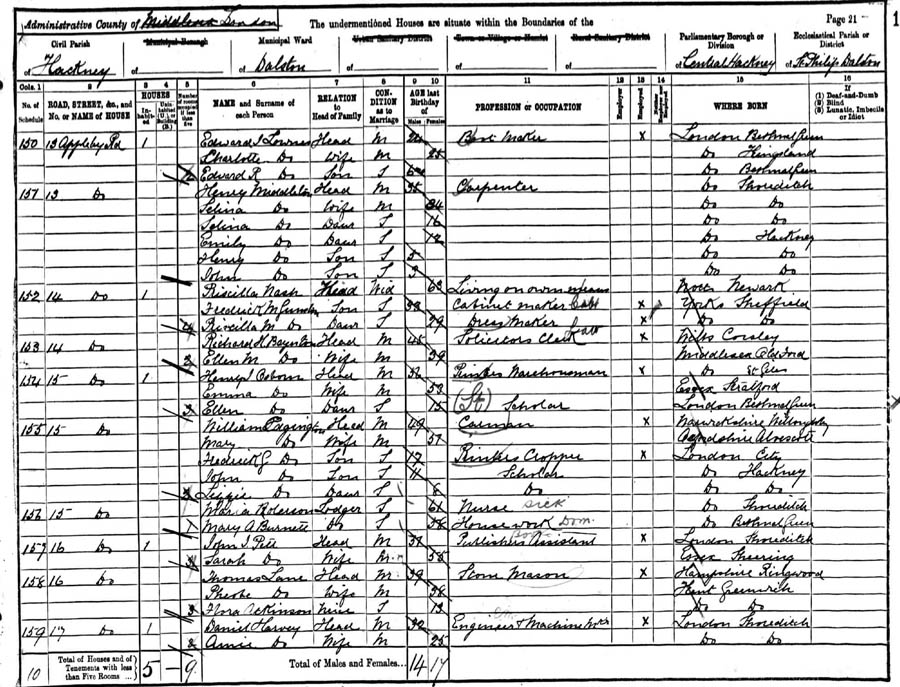
They haven't moved far; Appleby Road is in the same map right next to London Fields:

Hannah / Annie above is only 25 years old, and it is shocking to our modern sensibilities to discover that just 2 years later, in 1893, she dies:

Victorian people had it hard. Very, very hard. Hannah Partleton, who was born in the Workhouse and grew up in an orphanage, died on Monday 09 October 1893 at age 28, of Pulmonary Tuberculosis, Exhaustion and Asphyxia.

Pause for a moment as we might imagine how Rebecca feels about this. This is her first-born child, whom she had to let go to the orphanage, and then brought back home. Rebecca was 57 when her daughter died.
At the next census, in 1901, as seen below, we find that Daniel Wittle Harvey has married again and has children by his new wife. They are lining at Eleanor Road, on the north edge of London Fields:

So, what about Hannah's big sister, the mysterious Annie? She only appears once in the records, in the 1881 census. The rest of the evidence suggests that there is no such person, including the fact that Hannah plainly calls herself Annie. Our view at the moment is that there is an error in the 1881 census and that Hannah was in some way recorded twice, or confused with some other person. It's hard to tell among the fibs and duality of names.
And little Emma? She is married at age 20 in October 1889 in Hackney to Henry C Porter, a general labourer. Below we we see them in the 1891 census in Bethnal Green; Emma is a Laundress:
![]()
And below in the 1901 census in Hackney. Emma is now 32. They have no children:
![]()
Emma lived to the age of just 44; she died in 1915 in Hackney.
Rebecca Ann Partleton suffered the tragedy of outliving both of her daughters. In spite of all her trials and tribulations, alternative names, illegitimate children, deaths, workhouses, changes of address, split-ups and reunions, we actually have her record in every census for 60 years. Below, in 1891, she is a charwoman in Hackney.

Again we see her address, Blackstone Road is next to London Fields:

And in 1901, Rebecca, now 65, is a servant / companion to 85-year-old widow Elizabeth Ide in Hackney:
![]()
Rebecca Ann Partleton is a perfect example of what it was like to be born on the wrong side of the tracks in Victorian Britain. Her dad died when she was two, and through no fault of her own, having grown up in the workhouse, she could find no way to get away from the workhouse. Worse than that, history repeats itself
Despite all her hardships, Rebecca lived a long life of 88 years, finally passing away in 1824 in Hackney.
If you enjoyed reading this page, you are invited to 'Like' us on Facebook. Or click on the Twitter button and follow us, and we'll let you know whenever a new page is added to the Partleton Tree:
Do YOU know any more to add to this web page?... or would you like to discuss any of the history... or if you have any observations or comments... all information is always welcome so why not send us an email to partleton@yahoo.co.uk
Click here to return to the Partleton Tree 'In Their Shoes' Page.